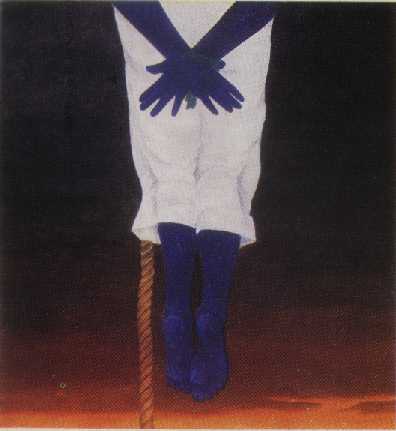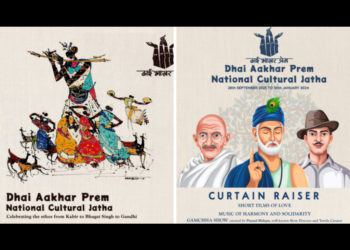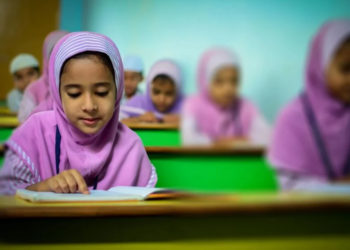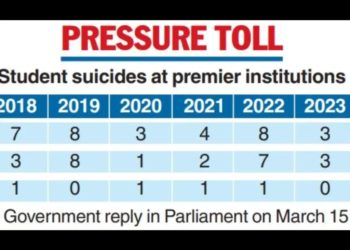Vrinda Grover, Ravi Hemadri, Bela Bhatia and Sukumar Muralidharan

© Veer Munshi, "Fate of a Kashmiri Pandit" / via Kashmir Lit
A fact-finding team of Vrinda Grover, Ravi Hemadri, Bela Bhatia and Sukumar Muralidharan released their report, Four Months the Kashmir Valley Will Never Forget at a press conference at the Constitution Club in Delhi on March 26, 2011. You can download the report (.pdf) here. Given below is the text of the introduction.
The mass uprising of mid-2010 in Kashmir sent shock waves across all of India. It caught most experts on Kashmir thoroughly unawares, after they had managed to persuade themselves that the situation in the valley – routinely referred to as “troubled” – had rapidly changed for the better.
Warning signals had emerged from the valley through the two years before, but these were evidently not heeded. There are, as a consequence, different opinions about when the 2010 civil disturbances in Kashmir, locally called the uprising or intifada, began. The killing of Zahid Farooq in the Nishat Brane neighbourhood of Srinagar in February has been identified in some narratives as the point at which public rage erupted. Others have focused on the cold-blooded murder of three who fell victim to the perverse system of military rewards and incentives for killing supposed “terrorists”. Shahzad Ahmad, Riyaz Ahmad, and Mohammad Shafi were shot down in Macchil village near Kupwara in a supposed “armed encounter” on 30 April 2010. It took the furious reaction of the local people for an official admission of error and a commitment to fix accountability for the atrocity.
As the official response took shape, people in Kashmir kept up the protests against a seemingly unaccountable deployment of security forces in their area. But maybe these dispersed and uncoordinated popular protests would not have gathered the dimensions of a full-fledged rebellion, had it not been for the killing of 17-year old Tufail Ahmad Mattoo in Srinagar on 11 June.
Different interpretations are possible, but few among those with a basic familiarity with Kashmir, would dispute that the clumsy and disingenuous official response to each of these incidents has fuelled public fury. Further, the unquestioning attitude in what is called “mainland India”, towards any official claims on Kashmir, has contributed little of value.
Civil society groupings in Kashmir affirm that the demonstrations the valley saw for three uninterrupted months since June 2010, were very much a reflection of the public mood, continuous in every sense with the eruption in 1989 of what they call the azaadi movement. The spirit and the scale of the 2010 uprising, though, have been of a magnitude not seen since 1989.
On the part of Indian State authorities1, the protests were described as a Pakistan conspiracy, or alternately, a shallow and short-lived commotion orchestrated by designated terror groups – such as the Jaish-e-Mohammad and the Lashkar-e-Taiyyaba. The Indian union government, after sending out signals of support to the state administration under Omar Abdullah, later seemed to turn its back on the beleaguered chief minister, characterising the disturbances as the outcome of a “trust and governance deficit”.
These arguments have taken up much public attention in recent times. But what has caused most alarm in mainstream political commentary is the discovery of a new weapon by the azaadi movement in Kashmir and a new mode of delivery. Stones thrown even with the most power, have little efficacy when facing firearms with lethal capacity. But stones have a moral capacity to shock and disturb, especially when they become the weapon of choice for a people that seem simply unwilling to accept defeat, even in the face of all the coercive might deployed against them.
The State has thought up various means of dealing with the situation, but politics has largely been absent from the mix. A parliamentary delegation that visited Srinagar in September and made the significant gesture of meeting with representatives of the so-called “separatist” political stream, succeeded to some degree, and temporarily, in cooling violent passions on the streets. The subsequent announcement by Prime Minister Manmohan Singh, that a team of “interlocutors” would be empowered to engage with all sections of opinion in Kashmir and discuss ways out of the trap of antagonistic politics, also briefly, held some promise.
The team of “interlocutors” as finally constituted, seemed an active effort at denying the political element. In Kashmir itself, the three-member team was dismissed as yet another dilatory tactic, which would do little to address the real issues.
The simultaneous announcement by the Prime Minister, that he would ask his Economic Advisory Council to explore ways of bringing about greater participation by the youth of Kashmir in the economic mainstream, was also viewed with considerable scepticism. Every announcement of a special economic “package” for Kashmir – as a magic bullet to appease its political grievances – is well remembered in the valley as yet another futile effort to change the subject and evade the fundamental issue.
The Director-General of Police for Jammu and Kashmir (J&K) has drawn several lessons from the unrest, but public attention most likely would be attached to his proposals on changing “standard operating procedure” (SOP), as used by police forces in dealing with mass demonstrations.
More than 120 people lost their lives and many more were severely injured, in the highly unequal street contest that went on in Kashmir last year. Contrary to the alibi advanced on their behalf, the security forces were by no means acting always in self-defence. Indeed, the people of Kashmir believe that the men in khakhi were actively involved in the coercive effort to deter and discourage demonstrations.
They showed little hesitation to preempt what they thought would be violence directed against them, by inflicting serious violence on all those who they thought capable of such actions.
Deterrence often slipped over into active repression, particularly in situations when it seemed likely that the “protest calendar” announced on a regular basis by Hurriyat leader Syed Ali Shah Geelani was likely to attract public support and loyalty.
A generation has grown to maturity in the turbulence of the valley’s two-decade long insurgency. And anger lurks just beneath the placid surface, waiting for an opportunity to express itself. Only the naive could have believed that the relatively high turn-out in the 2008 elections to the J&K legislative assembly constituted evidence that Kashmir was rapidly becoming reconciled to life under Indian rule.
Several Kashmir watchers within Indian civil society were completely puzzled by the events beginning June. This bewilderment also arose from the nature, scale and persistence of protests. Although the protests following the Shopian murders in 2009 and the transfer of land to a religious trust administering the annual Amarnath yatra in 2008, were no less widespread, a new vigour was manifest in the 2010 visitation.
There was also something new in the way each killing led to protests – typically associated with the burial ritual – that themselves became so threatening to the State agencies that they responded, more often than not, with disproportionate force. This in turn, set the stage for a further escalation in the cycle of killings and protests.
The idea of a fact finding team to Kashmir was mooted in August 2010. Apart from the most evident objectives such a team would set for itself in a situation of widespread human rights violations, the aim also was to talk to people and assess different shades of opinion on the origins of the problem, its present status and possible routes towards resolution. While the Kashmiri media has documented deaths and injuries through the valley’s long summer of unrest, there still were gaps in documentation, since numerous eye-witnesses to the lethal force applied by the security forces still believe that they have something to add – by way both of narrations of personal loss and considered opinions on the modus operandi of the Indian State.
What role did stone-throwing play in the protest strategies of Kashmir’s youth? How equipped were the security forces to cope with the situation without further aggravating matters? It was important in the context of the growing understanding that the security forces – far from being the solution to the Kashmir dispute, could actually contribute to its aggravation — to understand chains of command and discover how civilian casualties are seen within the apparatus of the Indian State.
Equally important was an assessment of the status of the promises made by the Omar Abdullah government, to bring human rights violators to book, to punish those who recklessly took life and to compensate – to the extent possible – those who suffered from the excessive use of force.
This fact-finding team (FFT) was in Kashmir at the end of October and met several families of those killed and injured during the period of maximum violence. Each member of the team spent varying lengths of time in the valley, but in total, roughly about twenty-five person days were put into the fact-finding exercise. In groups or individually, the team met the families of almost 40 persons who had been killed since the beginning of the civil unrest. Several individuals who had suffered serious injuries were also met. The team worked out of the state capital of Srinagar, and visited villages and towns in five of Kashmir’s ten districts: Baramulla in the north (Sopore and Baramulla tehsils); Anantnag (Bijbehara and Anantnag tehsils) and Pulwama (Pulwama tehsil) in the south; Badgam in the west (Chadura and Badgam tehsils) and Srinagar itself. Separate sessions were held with journalists and media practitioners, university teachers and students, doctors, lawyers and activists, besides officials in the police headquarters and the civil administration.
Some of this team’s findings have already been circulated through internet channels and discussed in conferences and seminars in Delhi and Mumbai. What follows is the final report.
First published in Kafila.




